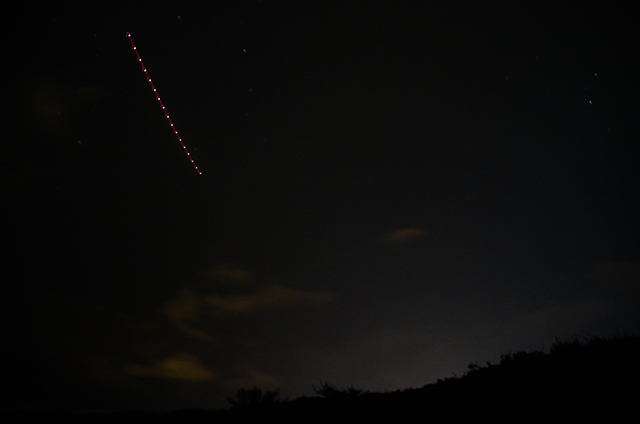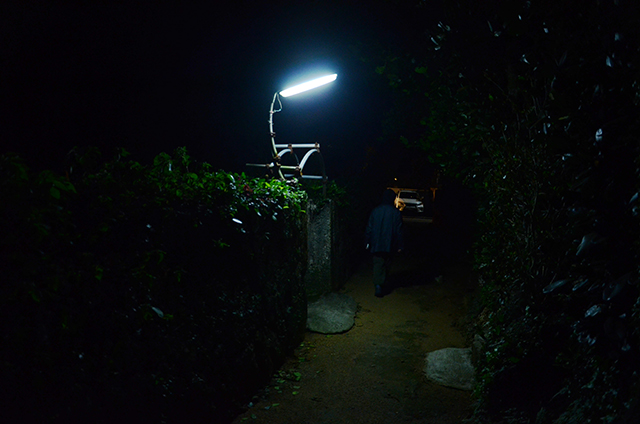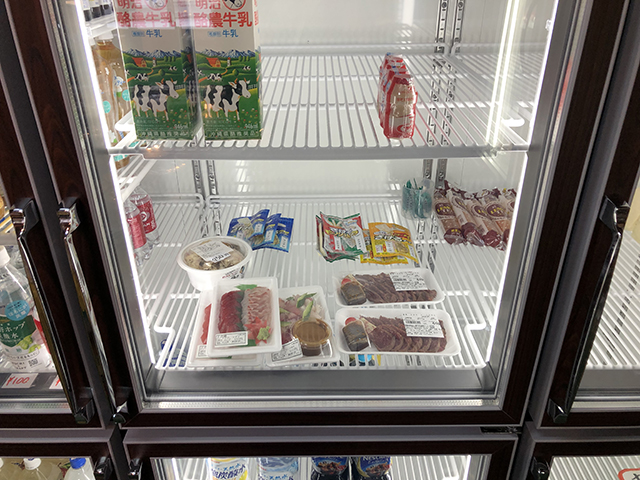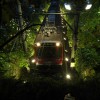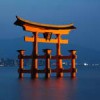Date of Issue: June 7, 2023
・Activity 1/ City Night Survey: Okinawa Main Island(2023.01.26-29)
・Activity 2/ City Night Survey: Kozushima+Niijima(2023.01.20-22)
City Night Survey: Okinawa Main Island
2023.01.26-01.29 Masafumi Yamamoto + Yuki Ito
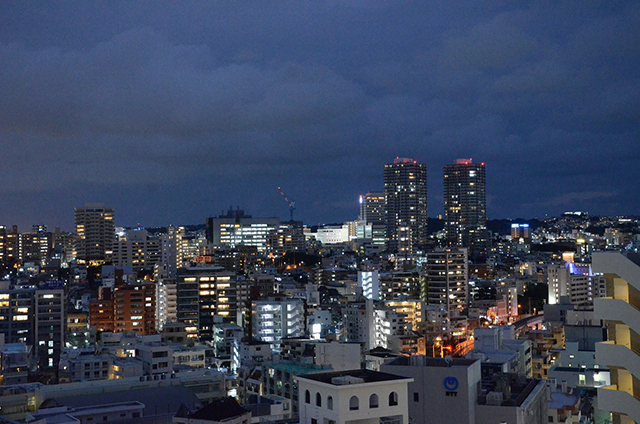
You can see a mixture of concrete buildings unique to Okinawa and high-rise residential buildings that were probably built in recent years.
Okinawa is a place where diverse cultures and histories are intertwined. In Okinawa, each region has its own unique streetscape, and this is due to the fact that each region has a completely different historical background. The following is a simplified explanation of the historical background of each area. The Naha area was severely damaged in the war and was rebuilt; the Koza area was influenced by the U.S. military base and retains a strong American culture; and the Bise and Imadomari areas retain the traditional streets of the Ryukyu Islands. By comparing the light environment of each area, this survey sought to determine what kind of lifestyle culture and light features each area has, and what kind of light is unique to Okinawa.
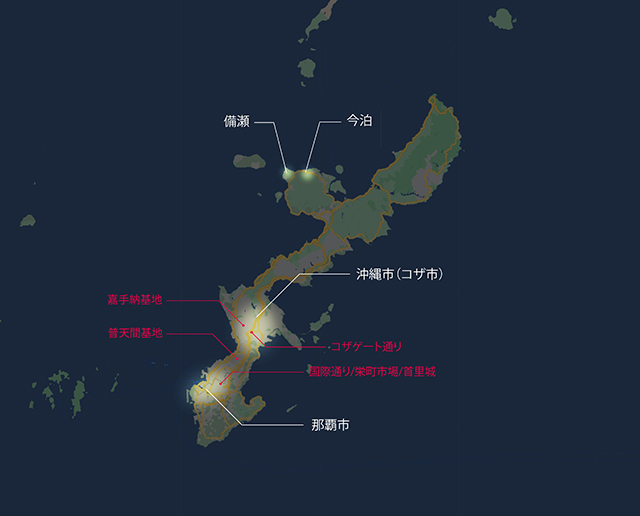
■Sakae-machi Market
Sakae-machi Market, located in Naha City, is a shopping street that was established during the postwar reconstruction period and has remained almost unchanged since then. Today, the market is a lively place where locals gather during the daytime, but at night it transforms into a more local haunt, drinking district that is quite different from the impression it gives during the daytime. The only light at night is from the taverns and the faint fluorescent lights in the upper part of the shopping street. (Floor illumination: approx. 20 lx) The illuminance alone gives the impression of dimness, but the actual atmosphere was not as dark as the impression given by the illuminance. I wondered why, and I think it may have something to do with the local residents. The locals extended their seats outside the stores and held parties, and their lively voices spread throughout the entire shopping district. Perhaps this is why the atmosphere of Sakae-machi Market gave me a completely different impression from that of the light
evaluation, even though the space was dark in terms of illumination.
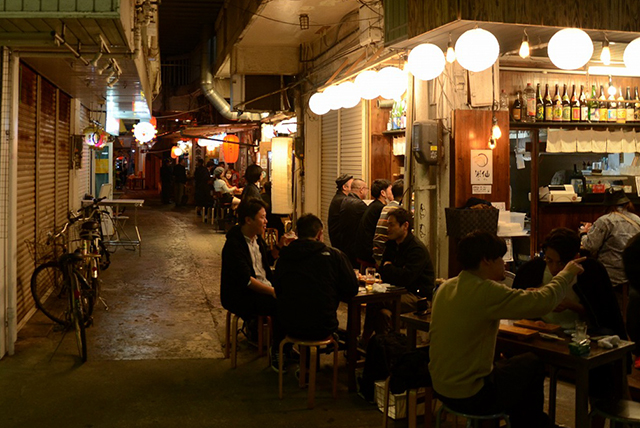
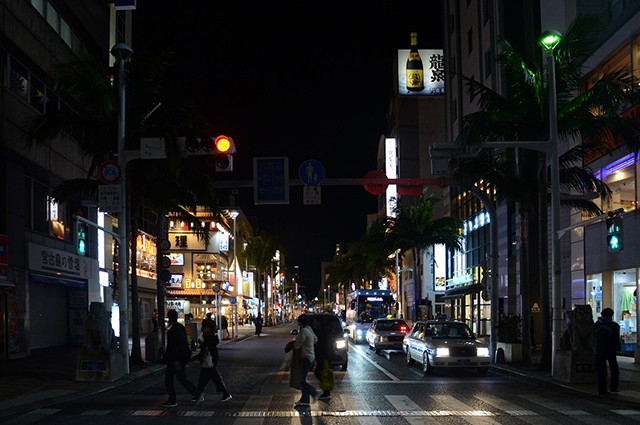
■Kokusai-dori Street
Kokusai-dori Street is crowded with tourists and lit up with twinkling lights. Many people must think of Kokusai-dori when they think of Okinawa. The lighting environment is an intense mixture of piercing light from electronic billboards and tivoli lights attached to facades. Some of the streetlights were lit green in places, perhaps due to deterioration over time. The uniformity of illumination and color temperature is also disorderly (50 to 400 lx, 2700 to 4800 K). The space was a mixture of various light elements, including a convenience store that used 2700K light, which is rarely seen even in Tokyo. It could be said that the light environment is not unified, but it is a glittering spectacle not often seen on the island of Okinawa, where people are attracted by the glittering light, and it may be one of the most representative views of Okinawa today.
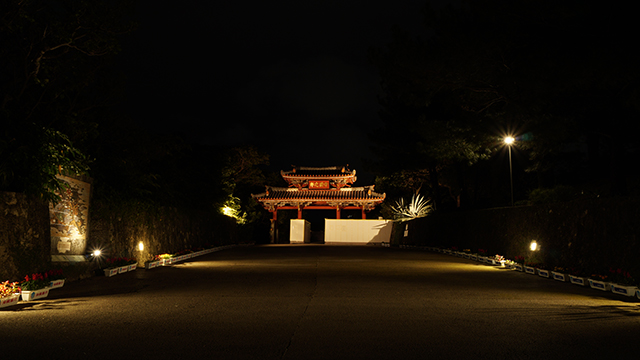
■Nightscape
It is said that 90% of buildings in Okinawa are constructed of concrete to prevent damage from typhoons and termites. With such a background, expectations were high for what the nightscape of Okinawa would be like. In reality, however, many high-rise residential buildings built in recent years were lit up, and the concrete houses and red-tile roofed houses that are representative of Okinawa were not noticeable. To be honest, the nightscape was not much different from that of other cities, which was disappointing because we had expected to see a more Okinawan cityscape. Yet, we were able to see our image of Okinawan housing from Shurijo Castle. This view of flat-roofed concrete houses was exactly what we had imagined. Unfortunately, we were not able to photograph this view at night, but we wonder how these houses are lit up here during the night.
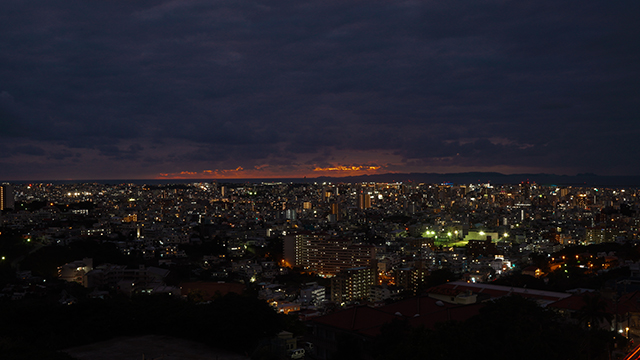
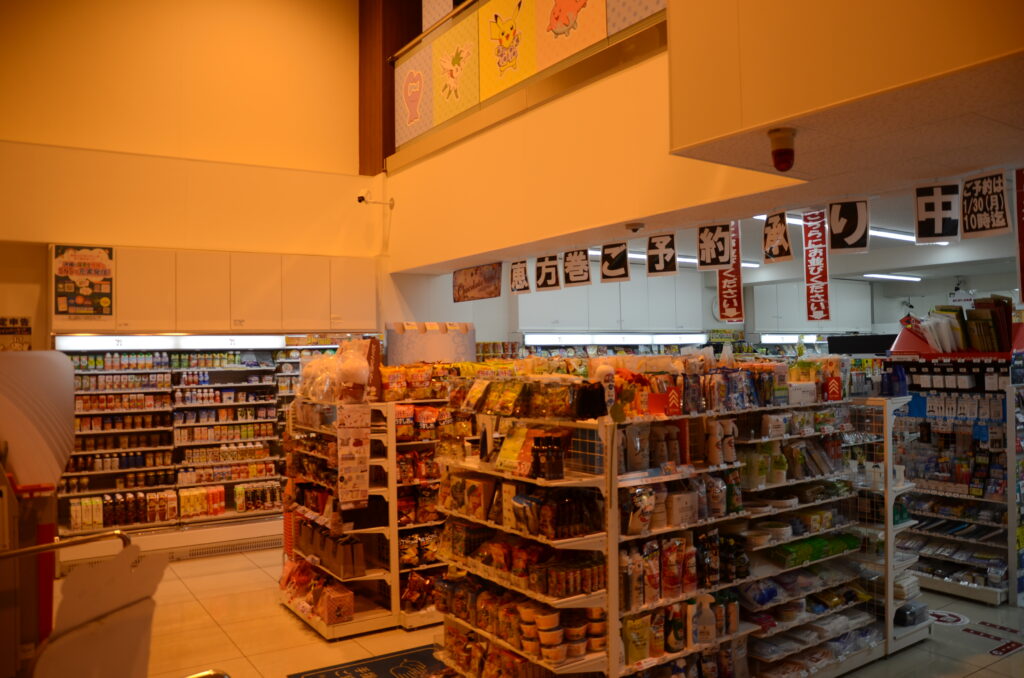
■ 2700K Convenience Store
We encountered a strange lighting environment at a convenience store located on Kokusai-dori Avenue. The convenience store uses lighting of different color temperatures in different areas, with the area facing Kokusai-dori lit by light bulb-colored lights, and white lights in the back of the store. Whether the light bulbs were installed outside in consideration of light leaking outside at night, or whether there was a mistake in the order and they had to install lights of different color temperatures not on purpose, the original intention remains a mystery…
■Shuri Castle
Shuri Castle, a symbol of Okinawa’s history and a source of emotional support for local residents, suffered an accident in 2019 when the main hall and nine other facilities were destroyed by fire. As if to cheer up the residents in the dark, the Shureimon and Kankaimon gates were quietly lit up, and the Shureimon and Huaiimon gates were lit up in the dark, as if to cheer up the residents in the dark.
Although not as powerful as the main shrine, their quiet appearance was a soothing sight. Bollard lights with a low luminance surface lined the grounds, and some residents went jogging at night. I longed to see the main shrine, which was supposed to be visible in the back, lit up strongly again someday.
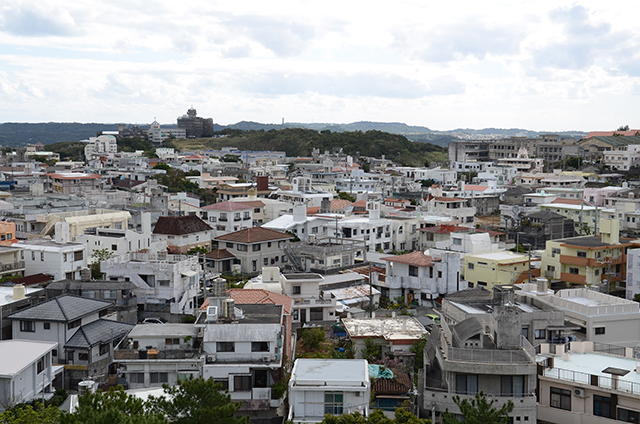
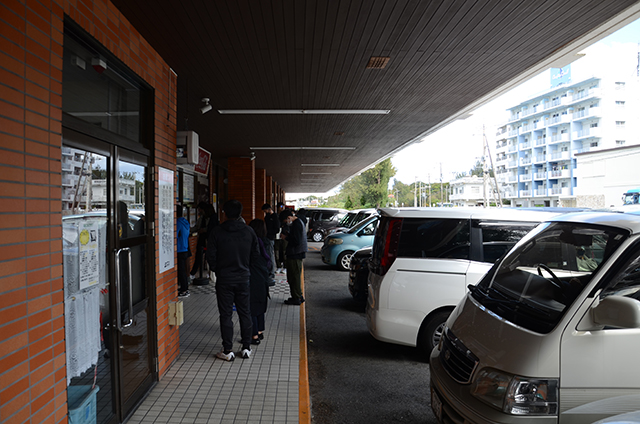
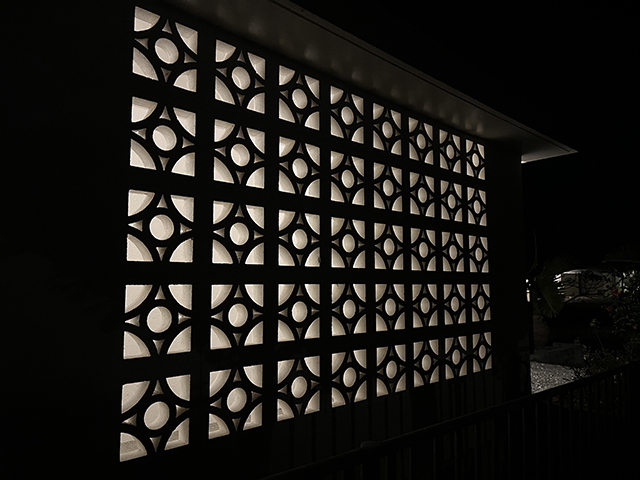
■How to deal with the strong sunlight
As mentioned earlier, Okinawa has a variety of nighttime scenes. Some places, such as Kokusai-dori Street, are brightly lit and bustling with people, while others, such as Sakae-machi Market, are dimly lit and exude a deep atmosphere. On the other hand, however, the daytime expression of Okinawa is uniform. During the daytime, strong sunlight pours down uniformly in all areas, illuminating the land of Okinawa. Therefore, measures to cope with the strong sunlight can be seen everywhere in Okinawa. Among them, flower blocks are a symbol of Okinawa.
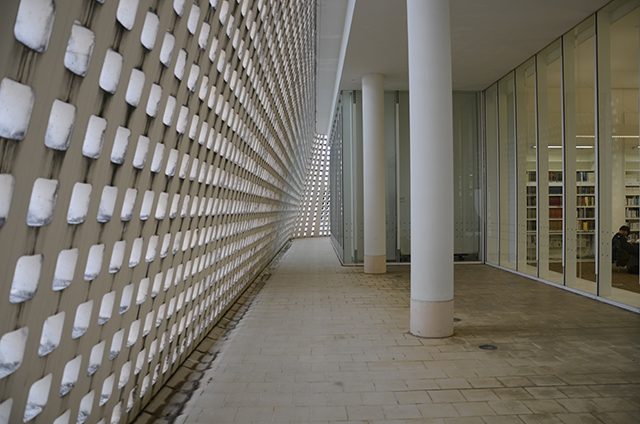
The flower blocks are designed not only to block strong sunlight, but also to allow soft light and breezes in through the gaps between the blocks. During the day, the shadows cast by the sunlight color the interior, and at night, the light from inside the building makes the flower blocks appear as silhouettes. In addition, the eaves of one building are designed to be much longer than the ceiling height to prevent the sunlight from reaching inside, and in the shopping area, tarps are always installed to softly diffuse the strong sunlight. (Yuki Ito)
■Futenma Airfield
When I thought I heard a roar from overhead, two fighter jets flew side by side. The presence of the base is familiar to us, as 70% of the main island is occupied by U.S. military facilities. Looking at Futenma Air Station from Kakazudaka-dai Park, the scale of the airfield adjacent to a residential area is overwhelming. As the sun sets, the runway approach lights and taxiway lights twinkle in the darkness as if they are weaving through the darkness of the city. The base facilities beside the runway are lit by sodium
lamps over a wide area, which do not blend in with the 4000K to 5000K cityscape of the surrounding residential areas.
It does not blend in with the 4000K to 5000K streetscape of the surrounding residential neighborhoods. It separates the two light environments like a border line laid out on the asphalt in front of the gate. The appearance of such light contours in various parts of the island is a scene unique to the base town.
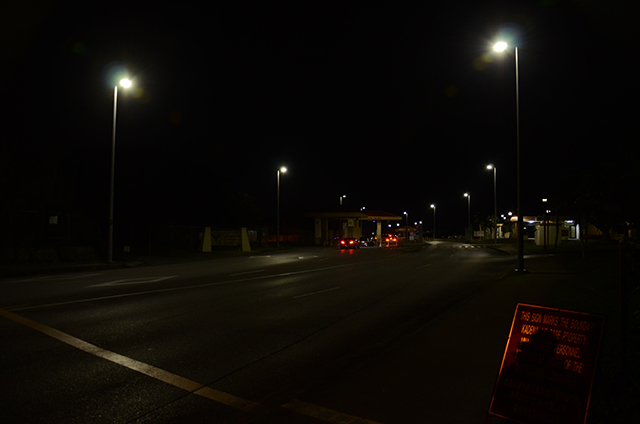
■U.S. Military House
From the high ground, a bird’s-eye view of the base house reveals a row of neatly lined buildings illuminated by 4000K pole lamps that look like an island. When you get close enough to see through the barbed wire, you can clearly see the light from the windows of the houses. They were all the color of light bulbs. Some of the homes had flickering lights around the windows, and through the curtains I could imagine the residents relaxing in their living rooms. In any environment, homes should be illuminated to provide a sense of peace and relaxation, free from tension. Above all, they must be more familiar with the color of light bulbs than the Japanese.
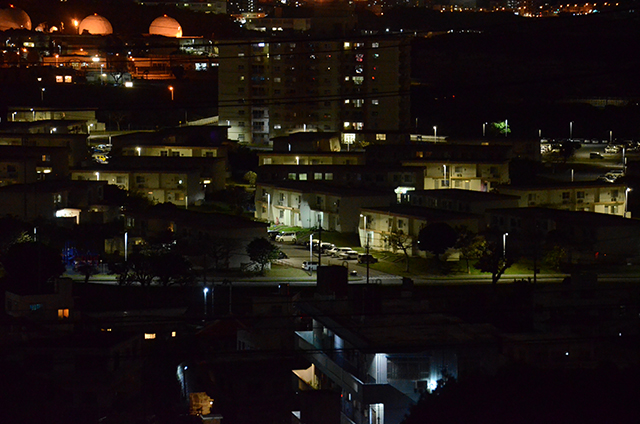
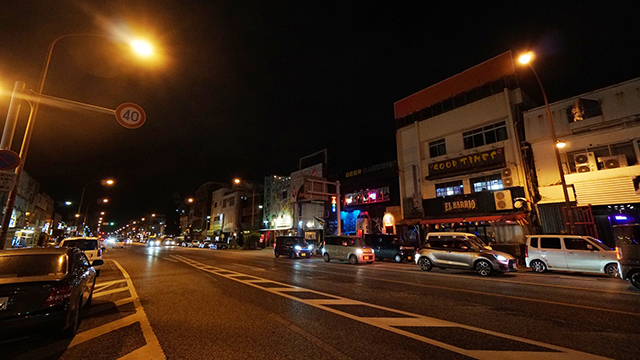
■Koza Gate Street
The main street leading from in front of the gate of Kadena Air Base is full of exoticism. The roadway is lit by sodium lamps and the sidewalks are white. However, the lights that stand out on the street are the store lights along the street. Neon lights and signs twinkle, and even the flickering lights of traffic lights are in sync with them. Indirect red and green lighting floats suspiciously in front of stores, and foreign nationals chat with each other at bar counters. These scenes continue on both sides of the street. The buildings are all about three stories high. The dazzling facade lighting that seems to dominate the night on the main street is generous and liberating, unlike the orderly light environment of the base. However, right next to the base, there is a residential area unique to Okinawa with concrete structures and water tanks on the rooftop, and Ryukyu-style residences scattered about, with the night streets illuminated by white street lights. Of course, many of the windows of the houses are also white. Away from the hustle and bustle of the exotic downtown area, the quiet and inorganic lights of the streets make you feel at ease, even welcomed by the unique lights of Japan. From a slightly elevated vantage point, the streets of Koza Gate Street looked like an oasis of
light that had suddenly appeared. ( Masafumi Yamamoto)
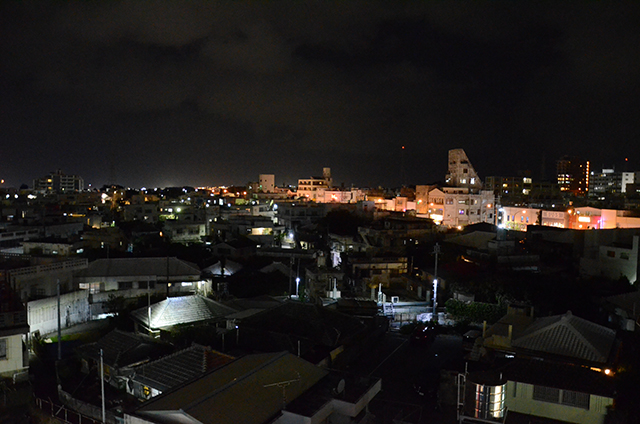

■The village of Bise
The wind blowing through the grove of Garcinia subelliptica trees shakes the trees and makes the outline of the sunlight falling through the trees on the white sand tremble slightly. Walking along the beach, the sea breezes from the shifting seas almost take away your strength, but the tree-lined paths block them and make you feel comfortable.
At night, however, the streets are so dark that you have to walk with a flashlight to feel safe. The intense environment of the seaside area also means that there are many broken appliances. Perhaps because of this, I was surprised at the brightness of lights in vending machines and public phone booths on the side of the road, which I usually do not pay attention to. Street lights are scattered at each intersection of the tree-lined
streets. An old private house restaurant, which must be visited by many tourists, illuminated Ryukyu roof tiles, and there was indirect lighting at the bottom of a sign indicating the route of the grove of Garcinia trees, which was a very small but dramatic illumination.
■Village of Imadomari
The unique Okinawan store operated jointly by villagers and selling goods necessary for daily life is called “Kyodo kiosk. We visited Moroshi Kyodo Kiosk, located on the outskirts of the village of Imadomari. According to the clerk, it is no longer operated under this system. The shop sells a full lineup of daily necessities. Come to think of it, at the market in Naha, which I visited on the first day, fresh foods were sold under high color rendering light. However, the sashimi at the public store was illuminated by a white fluorescent light. It is not necessary to go to the trouble of attracting the food to be sold. Garcinia tree is the symbol of both Bise and Imadomari, but it is not lit up at night. It is frustrating to think that if they were illuminated, the night view would be more beautiful. I gently changed the angle of the spotlight that was illuminating the ground of the Fukugi trees, and when I shone it on the trees, their large branches floated above my head.
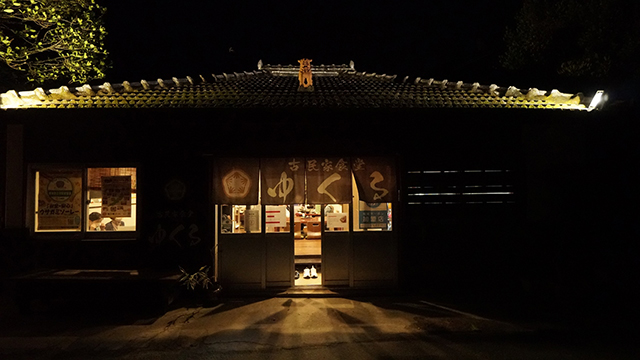
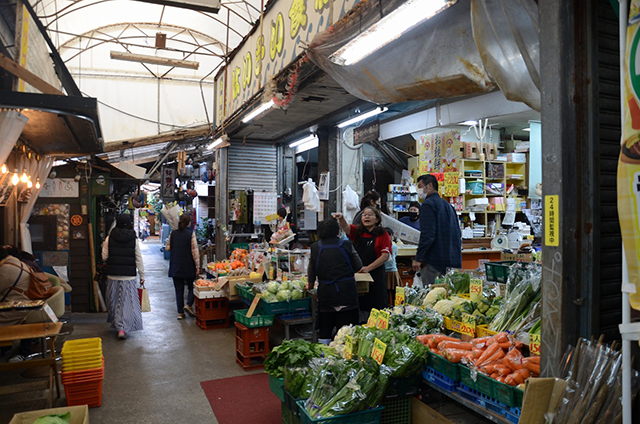
■Lifestyle and Lighting in Okinawa
The Nakamura family residence is a traditional Okinawan dwelling in its complete form, but the orderly arrangement of pendant lamps does not evoke an Okinawan atmosphere. The old private house inn where we stayed that day also had twinkling lights on the ceiling of the first room. When I explained to the innkeeper how I had traveled around the island to investigate the light environment, he showed me an oil lamp from his warehouse.
I found a diorama with the lamp hanging from it at the Okinawa Prefectural Museum, which I visited on my last day. I wondered if the lighting in Okinawan residences has changed with the waves of modernization, just as it has on the mainland. A cantera made of empty cans with English letters on display at the museum shows the influx of American culture and the poverty of the time. I was reminded of the words of a gallery owner I met on this trip who has lived in Okinawa since the reversion: “Inside the base was heaven, Okinawa was poor. “The lighting that supports life in this island nation living in harmony with its rich nature is unique in each of Naha, Koza, Bise, and Imadomari. The symbiosis of all these elements in one island nation forms the one and only light environment unique to Okinawa. They stand side by side in the rich and harsh natural environment and support the lives of the islanders. (Masafumi Yamamoto)
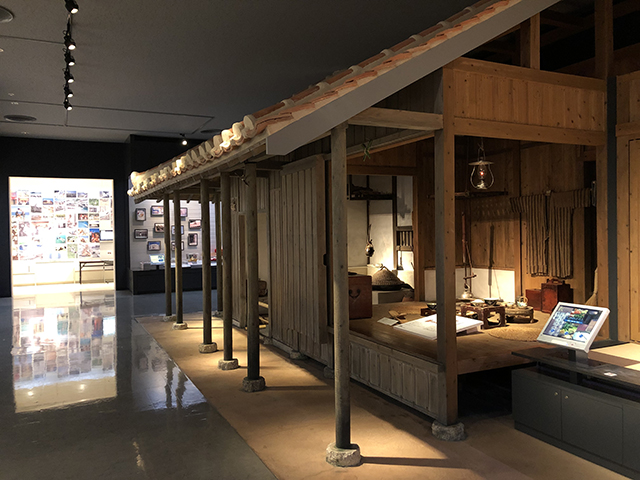
City Night Survey: Kozushima + Niijima
2023.01.20-01.22 Yuichi Anzai+ Chuanyi Liu
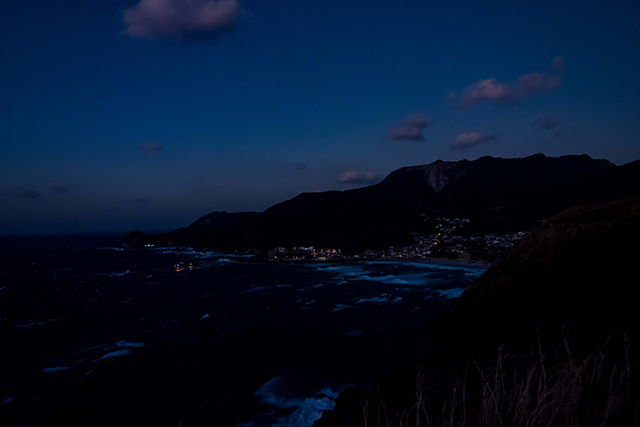
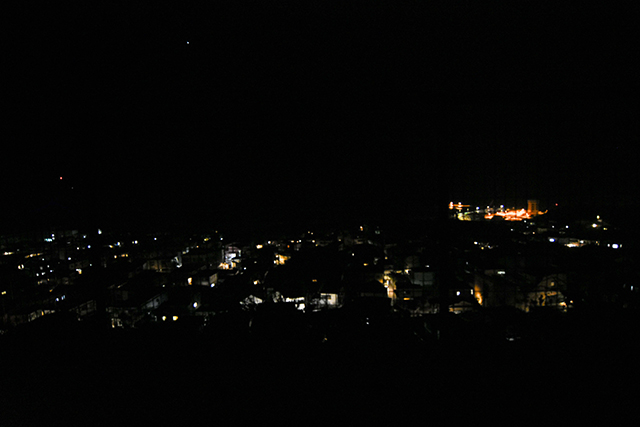
■Kozushima Village
Kozushima is located about 180 kilometers south of central Tokyo with a population of about 1,800. The terrain is complex, with almost no flat land. The village is located in the center of the island at the foot of Mt. Tenjo. The impetus for the starry sky protection activities on Kozushima came from a comment made during a student internship program by the Tourism Foundation in 2016, that the night sky was as beautiful as a planetarium. The starry sky, a common sight on the island, has become a tourism resource. An island-wide effort to protect the sky began. Specific efforts include replacing streetlights and security lights with fixtures with 0% upward luminous flux and 2,700K color temperature, holding explanatory meetings for residents and regular workshops with experts to gain their understanding and cooperation in light pollution and starry sky protection activities, training islanders as guides, and holding star gazing events to protect the night sky from light pollution and communicate the appeal of the starry sky both on and off the island. The island is also working to protect the night sky from light pollution and convey the charm of the starry sky to the public.
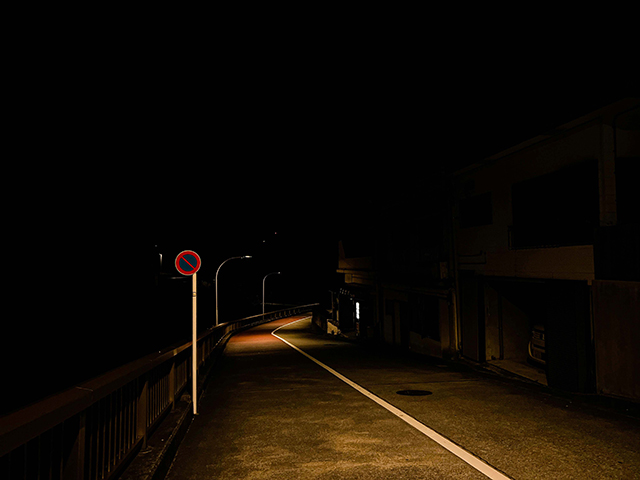
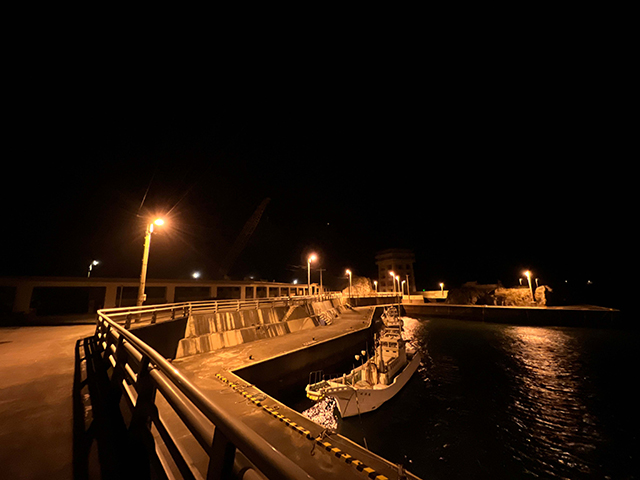
The “Light Pollution Prevention Ordinance to Protect the Beautiful Starry Sky of Kozushima Village,” which specifies the responsibilities of residents and businesses to prevent light pollution, will be enacted in 2019, and rules are being developed to limit the lighting equipment that can be used, lighting methods, and the time of use. The survey began on the main Kozu road, a trunk road. Pole lamps about 8 m high illuminate the road at 25 m intervals. The floor directly under the lamps is well illuminated at about 100 lx. The glare of the light source the one can feel is subtle, but the brightness of the road surface and the dark surroundings give the impression of being under a spotlight on the stage when you are under the pole lamps. This was the first time for me to see a road where all the lights were 2700K. It was unfortunate that the whiteness plus luminosity of the vending machines stood out in that light environment. The narrow
streets in the village are equipped with security lights at a height of 3 meters. The luminaire has a luminous flux of about 20 lx on the floor directly below it. There is no upward luminous flux, and the light illuminates the confluence of roads, corners, and other places where it is necessary for safety. Even under the light pollution control lighting, I did not feel any negative darkness, such as danger or fear. What surprised me was that my eyes began to catch the light of the stars just a short distance away from
the road lighting. The number of stars is completely different from the sky in the city center. It is a common sight for the locals, I was told.
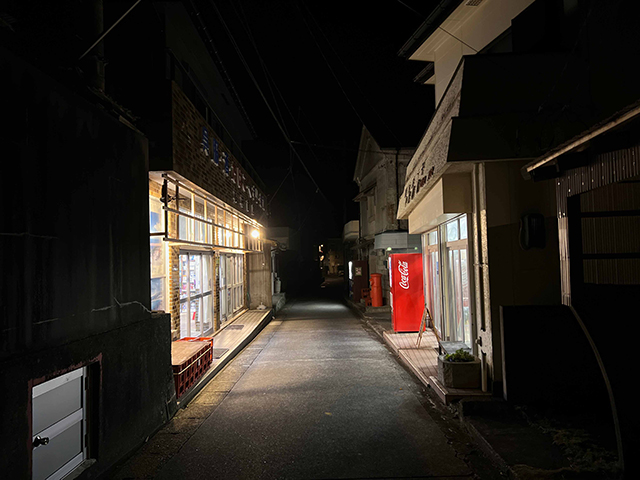
While walking along the street in a calm light environment of 2700K overall, I suddenly encountered a scene where light leaking from a store enveloped the street. 4200K, about 50 lx in front of the store. It is a leakage light of general fluorescent lamps, but I
feel it is quite bright. This may be because the brightness of the island as a whole is suppressed and the light emitted from the standing surfaces is low. When we asked a member of the tourist association, he said that while they seek to understand light pollution, their priority is the livelihood and safety of the residents. The village streets stand out in an environment where multiple lights do not clutter the streets, and each light stands out. It was an interesting discovery that the impression of the casual light of daily life, such as light leaking from houses, was different from big cities.
■Stargazing
During the Kozushima survey, we also participated in a stargazing party guided by a local guide. The event was held at “Yotane Plaza” on high ground on the east side of the village. It is located right next to a residential area, just a few meters above sea level, but the plaza is pitch-dark. No light from streetlights or stores could reach the square. The sky quality meter, which measures the darkness of the sky, reads about 21 (mag/ arcsec²). It is possible to recognize light up to 6th magnitude stars, and in summer the
Milky Way seems to be beautiful. Unfortunately, the sky was cloudy and there was a strong wind, but a star-filled sky occasionally peeked out from between the clouds, and the guide explained the stars and constellations in the limited visibility. The light that had traveled from the stars tens of thousands of years ago and now finally arrived on earth was shining down on us. I was deeply moved. What struck me about the guide’s words was that all starlight is inherently different and colorful. In dark places, the human eye’s rod cells become active, causing objects to appear black and white. If we could see the true light of the stars with the naked eye, we would be able to see a night sky as colorful as that of a busy city center.
The sky directly above the island is dark, but the ridges of the mountains on the Izu Peninsula side are dimly lit. It is said that light from the city center illuminates the night sky. Also conspicuous in the dark sky were the lights of airplanes heading for Haneda and Narita airports. The planes frequently blocked the light of the stars as they entered landing gear and lowered their altitude. It was unfortunate to be brought back to reality while interacting with the stars, but I think it is amazing to be able to enjoy such a starry sky so close to the city center.
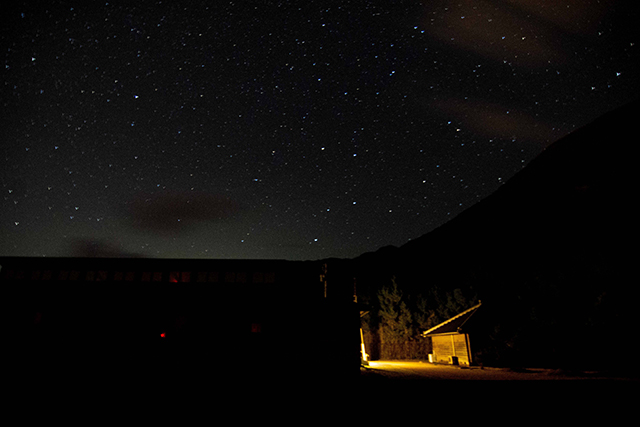
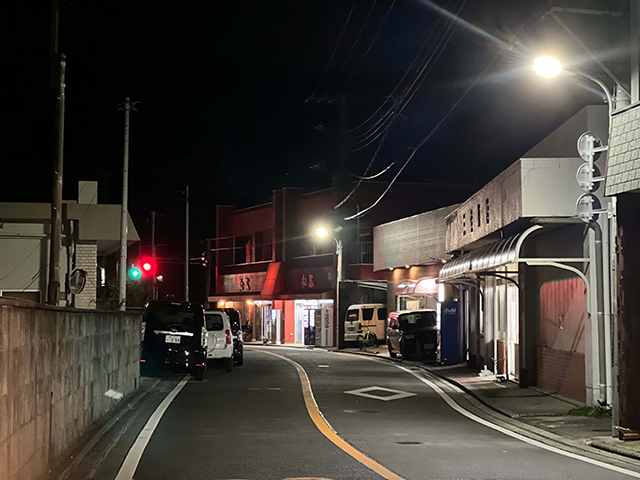
■Niijima Honcho-Town
Niijima-Island is about 160 km south of central Tokyo with a population of about 2,500. The island is larger than Kozushima in both area and population. Although the land is flatter than on Kozushima, Miyazuka Mountain, which borders the main village, is very impressive. The main road in the village is the Niijima main road, which crosses the center of the village from east to west. Restaurants are relatively clustered along this road. From there, stretching eastward, one can connect to Metropolitan Route 221, which leads to Niijima Airport and Habushiura Beach, famous for surfing. Traditional Japanese hotels and stores are scattered throughout the village in residential areas. Perhaps because the survey was conducted during the off-season for tourism, the Niijima-Island main road was almost empty during the daytime, but at night it became a lively scene as the lights of restaurants and stores began to shine and cars lined the road. When we asked the innkeepers, they told us that it was just time for the New Year’s party. From each restaurant, we could hear the lively voices of both locals and those posted from outside the island.
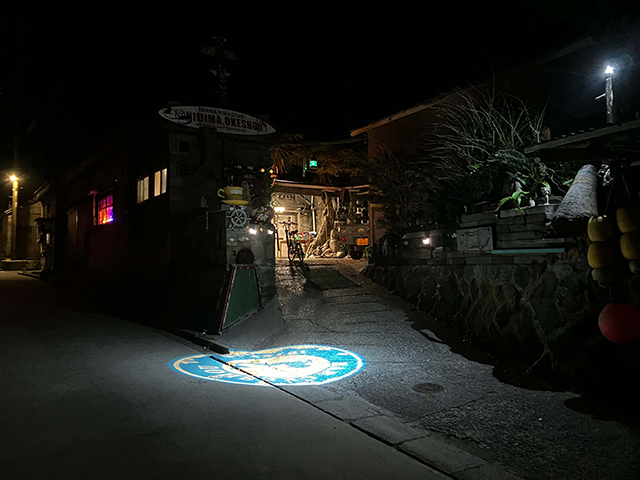
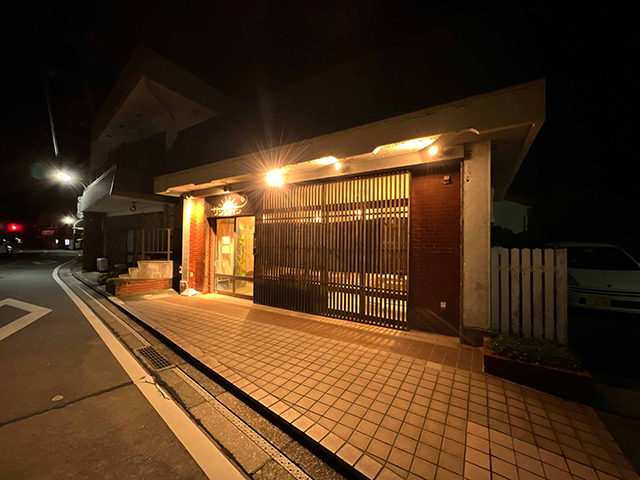
The lighting in front of the store is diverse, including spotlights, bare bulb type lighting, floodlights, and a projector with the store logo. Color temperatures ranged from 2700K to 5000K. However, the stores are scattered along the main street, and the scene was not noisy with a lot of lights. In fact, each store was worth a stroll with its own unique light at a distance from the others. The street lights are 5000K LEDs, illuminating the floor at about 40 lx at a height of 5 m. The light is strong both upward and horizontally. The lights emit strong light upward and horizontally, giving a dazzling impression compared to Kozushima-Island. The glare of the light source makes the surrounding environment seem darker in comparison. When you turn off the main road to a side street, you will enter a residential area, where the security lights are mainly used. I was surprised to find that the atmosphere of the nearby island was completely changed by the street lights.
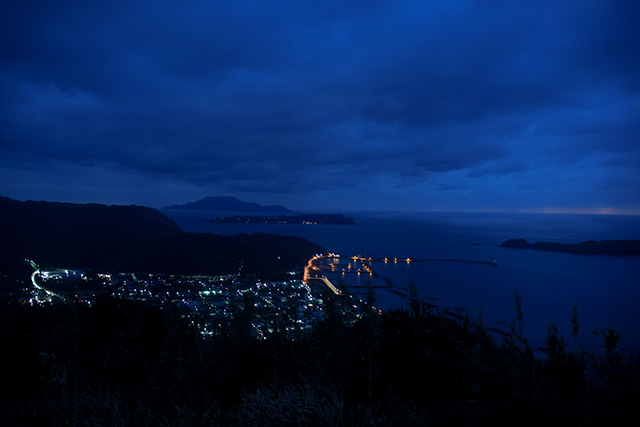

■Koga Stone Architecture + Moyai Statue
Niijima-Island is one of only two places in the world where biotite rhyolite (koga stone) is quarried. Koga stone has been used as a building material on Niijima because it is porous, lightweight, fire-resistant, heat-insulating, acid-resistant, sound-dampening, moisture- and vibration-resistant, and easy to process. At first glance, it looks like concrete, but up close, the glassy texture is beautiful and shiny. Walking around the village, one can see many walls and buildings made of koga stone, but unfortunately, newer buildings seem to be replacing koga stone with more common building materials. Many of the existing buildings are now empty and no lights are shining. Not long ago, until the Showa period (1926-1989), there were streets only on Niijima-Island.
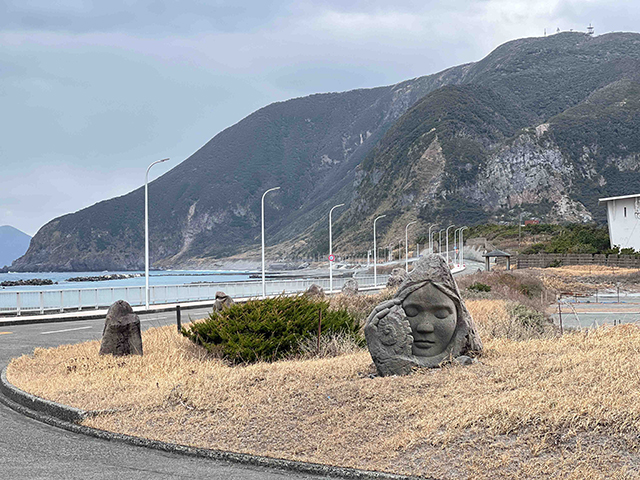
One of the most familiar works made from Koga stone for people living in the Tokyo metropolitan area is likely the Moyai Statue in Shibuya. It is said that the origin of the statue dates back to the 1960s, when island villagers carved a figure of an exiled person they admired out of Koga stone. In the 1970s, hands-on Moyai statue carving tours began to be held, attracting many tourists to the island. Thanks to that, there are now over 100 unique Moyai statues scattered around the island.
The highest concentration of these statues can be found along the road by Maehama Beach, where they welcome visitors arriving by ferry. At night, the area transforms into a distinctive landscape: 8-meter-high sodium and LED streetlights are placed roughly every 25 meters, softly illuminating the road and the statues with a gentle glow. It’s a uniquely atmospheric scene.
Since this landscape is unique to the island, it’s tempting to imagine each statue being lit carefully and individually. The deeply carved faces create powerful shadows that are striking even with subtle lighting. Ideally, I’d love to bring different types of lighting equipment and experiment with how each statue can be lit.
The Moyai statues are scattered across the island, and some rare ones are difficult to find. While I couldn’t find any statues that are actively lit up in my research, it’s still possible to enjoy their varied expressions at night as they subtly interact with the ambient light around them.
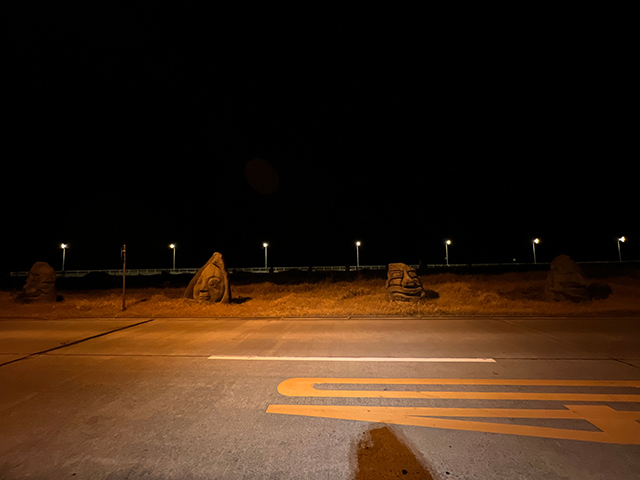
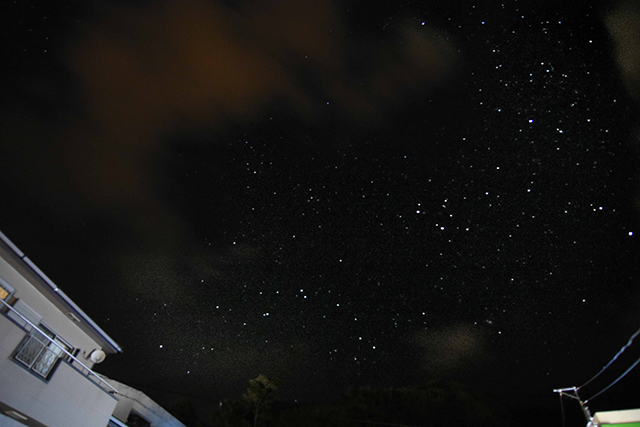
■Summary
The Kozushima-Island survey allowed us to see the island-wide efforts and effects of light pollution countermeasures and starry sky protection. However, it seems to be having a positive effect not only on the starry night sky, but also on the nighttime
ecosystem of plants and animals. According to the star guide, many migratory birds fly to Kozushima-Island, and many of them were blinded by the glare of the streetlights at night, hitting obstacles and falling down before the streetlights were replaced. There was also happy news that sea turtles had returned to lay eggs at Maehama beach. Hatchlings return to the sea at night by the light of the moon. The bright artificial light environment can be a threat to the turtles’ lives. However, there is also the life of the residents on the island. Kozushima Village measures the night sky four times a year, with the goal of keeping the results from worsening over the previous year. It has been about three years since the island was certified as a starry sky protected area by the International Dark Sky Association in 2020. The survey also raised concerns about the island’s future efforts to strike a balance between protecting the safety of island residents at night and the lights necessary for events and commerce, while at the same time maintaining a balance with natural light and the ecosystem of flora and fauna. A star-filled sky and the artificial light that supports it. We look forward to the development of a light environment that can only be seen on Kozushima-Island. In contrast to the Niijima survey, we were able to investigate a variety of artificial light environments. There is bustling light, different color temperatures, glare from streetlights, and pitch-dark roads. The unique sight of Moyai statues also made for a unique night on Niijima, quite different from that of Kozushima-Island. The statues of Moyai that we encountered during our research were quite freely designed, with some having calm, dignified, or stern expressions, and no two statues had the same face. It was uncommon to see so many unique faces scattered all over the island. If the stores, moyai statues, and Niijima-Island’s unique koga stone architecture were to be covered with a variety of lights as a nightscape for tourists to enjoy, the nighttime character of Niijima would grow even more unique. This survey of two consecutive islands in the Izu archipelago allowed us to experience that the light environment differs greatly even among the nearby islands. Tourism is one of the main industries of both islands, and I believe that the unique charm of each island will continue to attract tourists in the future. (Yuichi Anzai)
